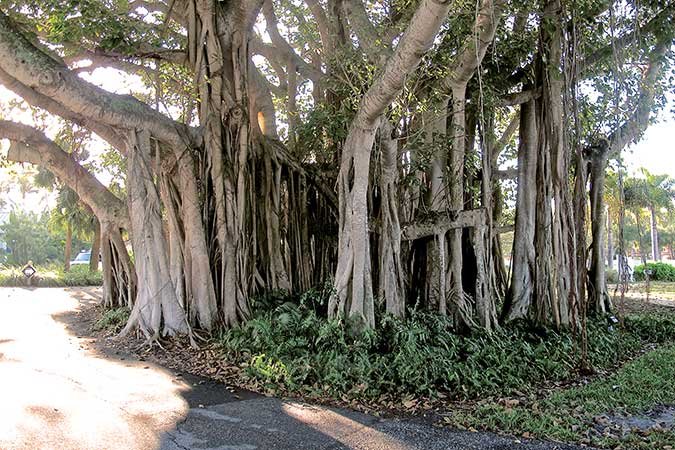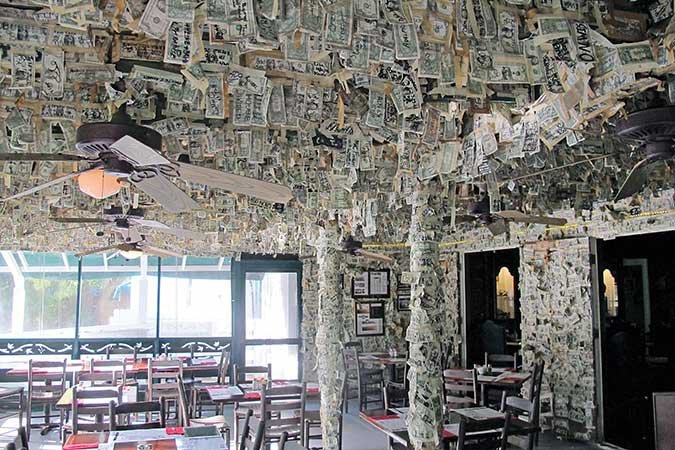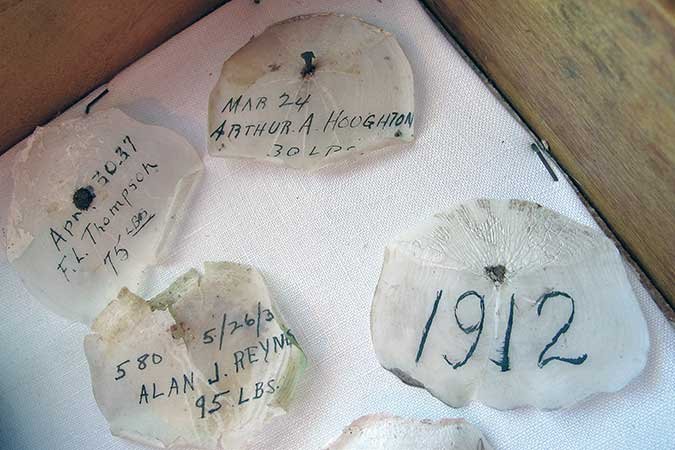By Douglas Bernon
Among the many delights of cruising the shallow waters of Pine Island Sound in southwest Florida is that, even for powerboat beginners, it requires only straightforward eyeball navigation. As Captain Chris, who trained us in the operation of our beefy trawler, said, "Just follow the ICW markers. And remember, ‘Keep red right when returning to Texas.'" What, we wondered, does Texas have to do with it? Then it sunk in. We were on Florida's Gulf Coast; the terminus of the Gulf ICW is indeed Texas.
Southwest Florida Yachts (SWFY) custom designs itineraries that cater to the tastes and skills of its charterers. For my wife, Bernadette, and me, staffers laid out comfy daily distances that gave us time for swimming and hiking. Before we ever left the company's dock — actually, before we arrived — they'd made all our marina reservations. They also figured out where we should be on which day to pick up our friends Angie and John, who were joining us for half the charter, and where to drop them off later in the week for a water taxi back to where they'd started.
Once Captain Chris, in a formidable act of faith, deemed us unlikely to sink NautiGator, our pristine Beneteau Swift 44 trawler, which turned out to be a comfortable and easy-to-drive vessel, we scurried to the local grocery store and wildly overstocked on victuals. To look at the trunk of our rental car groaning under the weight of our larder, one would think we were headed out for years with no likelihood of encountering the many restaurants into which we were already booked. John took to referring to our holiday as "float and bloat."
Pine Island Sound serves up a western sky with few obstructions between you and the horizon. Sunset lingers longer. Or maybe it's just cocktail hour, because every day we were tied up or anchored by 1600, waiting for bands of color to layer the skies and dazzle us, which most every night they did. Some people claim that advance preparation — or patient waiting — will make a sunset's illusive green flash more likely. Bernadette and I lived full-time on sailboats for many years, and flash-a-logically, we've always come up empty. I think of the green flash as a mariner's snipe hunt. If someone ever did catch sight of a snipe, the search would lose its luster altogether. I'm dubious about so many sightings. I once had a sweet but peculiar-looking dog who I claimed was an Alsatian Spindle Hound specially bred to herd flounder in the shallows. Folks would say, "Yeah, I've heard of them." One guy said his cousin had one.
It was a comfortable several-hour putter to Gasparilla Island. The entrance channel to Boca Grande Marina funnels from broad to squiggly narrow, but it's exquisitely marked. Gasparilla is a crossroads for boaters, many of whom are on the Great Loop. We met a Canadian couple on a PDQ 36 who were headed to the Bahamas. A 40-foot MJM was lying sleekly against the far dock, stretched in an elegant flight. I commented to the owner how gorgeous she was.
"I know! I just can't believe it," he said. "I love looking at her, too." Across the dock was a recently retired couple on a Nautical 331, then in their 11th day of cruising on a boat that they didn't really know but that had captured their hearts. With pride and not just a little apprehension, they spoke of their "planned circumnavigation." Who knows if they'll do it, but their aspirations made us think about what stretches of spirit we still want in our own lives and which dreams we'd rather hold in mind than memory. I was reminded happily on this trip that one of the keenest pleasures of boating is an unforced gregariousness among previous strangers, which invites unhurried and easier conversation than we allow ourselves on land.
 Banyan trees stand in watch over Gasparilla's historical transformation from fishing islands to resorts and second homes.
Banyan trees stand in watch over Gasparilla's historical transformation from fishing islands to resorts and second homes.
John and I walked the beach, then ambled around town, crisscrossing neighborhoods and imagining what it might be like to live in this meticulously manicured oasis of golf carts and the Paul Bunyans of banyans. With an architecture and pastel palette that's the same mix of calm and fussy as old Key West, Gasparilla is a quietly stunning place with oodles of shops and white sand beaches. We were stopped by an elderly gent who asked if we knew whose house we were walking by. We did not. He looked all around, then in a loud whisper said, "Marvin Bush, son of 41, brother of 43."
"Are you and Marvin buds?" John asked.
"No," he said. "I've never seen the man myself. My wife heard that's his house."
One late afternoon on Sanibel and Captiva islands, which have, grain for grain, the world's most shell-covered beaches, we started picking up a few beauties. But as our pockets groaned and our shorts started slipping, we became less greedy and swapped early finds for ones we liked more. Back at the Tween Waters Marina, I'd taken on what Bernadette called "the smell of the shell." A guy on the dock came over with a bottle of bleach and said, "Man, if you're gonna take 'em home, you better start soakin'." Eventually, we'd have to mail them back so the stench wouldn't pollute everything in our suitcase.
Walking the beach at Cayo Costa Island, a state park with equal beaches and way less hubbub than Sanibel and Captiva, we saw only a few people at sunset. One man's gait — his dance, really — caught the eye. Decked in camouflage gear and topped with a NY baseball cap, he moved like a slow-motion ice skater, sweeping his metal detector in an arc before him, leaning into each half circle.
"I come here every winter," he told us as we stopped to catch the evening's light show. "My best detector finds have been around Charlottesville, Virginia. I've found Civil War coins and silver pieces. I love to hear the clicking speed up when I'm over something. I don't do it for money. I'm here for the sunsets." Here was a guy who treasures the hunt more than the find. Sort of like me and green flashes.
The Most Impressive Being we met on this trip was the American white pelican (Pelecanus erythrorhynchos), a genuine snowbird whose annual migratory commute is from the Pacific Northwest to the Gulf of Mexico. These are seriously big birds; males can tip the scales at 30-plus pounds, and their wingspan is almost as great as a California condor. We saw them every day, first when leaving Tarpon Point Marina, where SWFY keeps its boats, about a mile out on a starboard sandbar. A row of giants were hunkered down near several of their spindlier, 6-pound, local gray cousins — a family reunion.
Entering the marina at Cabbage Key, when 30-knot winds and only one space left at the dock made our approach dodgy, the dock master helped us pivot our big boat around using spring lines and leverage from a piling. At Cabbage Key, we didn't touch our larder and instead ate at the island's one little restaurant, with its walls, columns, doors, window jambs, bar stools, and ceiling papered with actual dollar bills — an esthetic and cultural decision so absurd and symbolically perfect that one must linger to take it in.
 Dollar bills line nearly every surface of the restaurant on Cabbage Key.
Dollar bills line nearly every surface of the restaurant on Cabbage Key.
Local legend maintains this is where Jimmy Buffett wrote "Cheeseburger in Paradise." Maybe true, but I ordered the grouper. What we both liked about Cabbage Key were the walks through the woods. Orchids were everywhere, banyans provided a canopy, and if we were lulled by that calm, we could ramp up our heartbeats by reading the many signs warning us to be watchful for alligators.
With the wind picking up during the week, we headed next to storied Useppa, a private island accessible only by boat and restricted to members and guests. SWFY's owner, Barbara Hansen, is a member, so her charterers can dock at the marina and amble the well-signed botanical trail.
 Spirit houses hide along the walkways of Useppa.
Spirit houses hide along the walkways of Useppa.
A world of hanging moss and orchids, of Thai spirit houses tucked into cascades of bougainvillea, there's a feel of the Old South here. The restaurant at the Collier Inn has walls of giant mounted tarpon, old photographs of tournaments and members long gone, trophies, white table linens, and red-brocade furniture.
An island skinnier than six football fields at its fattest, and less than a mile long, Useppa serves up a story of the earth itself and a nuanced cultural history of the United States. Useppa was once part of the continental mass, visited by Paleo-Indians at least 10,000 years ago. By 3,000 B.C., when rising seawater had rendered it a ridge of an island, Calusa Indians came from the mainland in spring and summer. They used this land well into the 1700s, when, historian William H. Marquardt says, "they succumbed to slavery, warfare, and disease."
 Scales from giant tarpons, marked with the dates they were landed, showcase the region's legendary fishing.
Scales from giant tarpons, marked with the dates they were landed, showcase the region's legendary fishing.
By the late 1700s, Useppa was a Cuban fishing camp, and Union troops camped here during the American Civil War. Just before World War I, the industrialist Barron Collier bought the island and turned it into an enclave for the wealthy. In an ironic full circle, during the 1960s the CIA used Useppa for training soldiers to invade Cuba. This island has survived rising seas, tectonic shifts, continental reorganization, disease, slavery, avarice, war, and hurricanes. Useppa is not only beautiful; she's tough and resilient. Layer by layer, this is our country.
Having John and Angie aboard for several days was a treat. We've shared boats before. John and I have been close friends since childhood and tolerate each other's idiosyncrasies with amusement. We've known Angie for decades, too — one of the world's most naturally gracious people.
These are the kind of folks you want on a boat, where there are long hours uninterrupted by the demands of familiar routine, where you catch up on all the little things. How IS your cousin Elaine? Did your sister sell her house? Whatever happened to old so-and-so? Sprinkled through rambling conversations, these details piece together a richer picture of where each of us is, chats occasionally interrupted by the delight of seeing pods of fat little dolphins, which reminded me of the marshmallows my grandmother kept in a covered bowl near her reading chair.
Somehow, traveling on a boat inspires us to a more thoughtful day in which the unexpected becomes the adventure. There's something about breaking away and toddling around a new place on a boat that makes it easier every evening to grin and think, "Wow, today was a good day in my life." On board, boat life encourages a kinder give-and-take.
When moving between levels, for instance, one is likely to sashay aside to make way for the other — a moment of mutual civility and respect for space often missing in our daily lives. We slide into the shadow to allow another the space to pass in the light. When I noticed Angie and Bernadette both step aside to let the other proceed up or down the companionway, what struck me were their silent smiles. But I also thought about the word "companionway," that not-quite-here and not-quite-there space between levels of one's world — "com" and "pan" combine to give us "one who breaks bread with another." Seems right to me.
For Bernadette and me, our last day of breaking bread aboard was in Ding Darling Harbor. We still hadn't seen a green flash — a sighting for another day, perhaps, or another trip. We anchored early so we had time to swim, clean the boat, take in the peaceful mangrove scene, and still get NautiGator back home on time. We conjured a feast from what was left in the fridge. That day it was omelets with salmon, cherry tomatoes, Brussels sprouts, feta cheese — and, of course, bread we could break together.
— Published: February/March 2017

Phil Gilles
Direct: 239-425-5423 | Email: [email protected]
Donna Gilles
Direct: 239-425-5426 | Email: [email protected]
Donna and Phil Gilles are two of the most respected Pine Island Florida Real Estate Agents. Their dependability, honesty and integrity are truly a "cut above” in the real estate profession.
Donna and Phil started BlueWater Realty of Pine Island on September 11, 2002, realizing Pine Island was in need of a real estate family that was a step above the mass marketers that dominate the real estate profession. Donna and Phil’s in depth real estate training include: investment management, brokerage, marketing high-end homes, real estate law, ethics and practice.
If your immediate future requires counseling in the purchase or sale of real estate, please contact Donna or Phil. They are professionals who will work hard for you to help achieve your real estate goals.